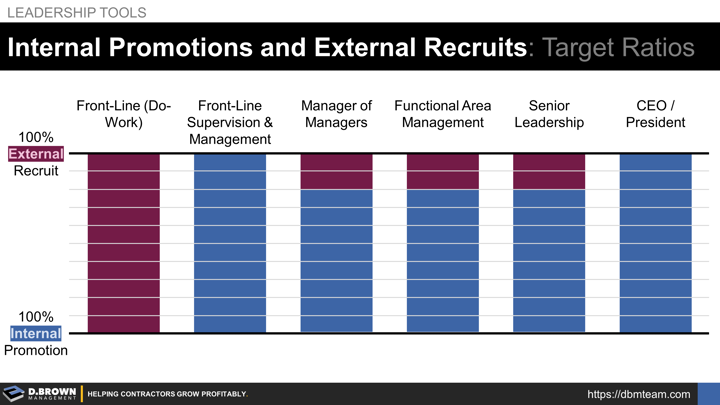This is an intentionally simplistic model, meant to be used as a guideline. There are many variables that we will attempt to cover below. Note that only a contractor at stage 5 or 6 of growth will have all these levels, and we will describe some of the differences in stages 1–4 below. Please contact us to discuss further and/or with any questions you have.
The Categories of the Team
- Front-Line: The people directly doing the work from Crafts people to Estimators to Payroll and everything in between.
- Front-Line Supervision and Management: Those who are directly responsible for managing the work of those on the front line, beginning with the Foremen. They are accountable for outcomes and for using systems and tools largely designed by others.
- Manager of Managers: Someone who manages other managers, such as a Superintendent managing Foremen. At a larger company, this may be the Project Executive role responsible for several Project Managers. They are accountable for outcomes and for using systems and tools largely designed by others.
- Functional Area Management: Those who are responsible for one or more functional areas that make up The Contractor Business Model. They are both accountable for outcomes as well as for the design and management of the systems and tools used by others. Examples may be Chief Estimator or Controller. In a smaller contractor or with a smaller overall team, this person may also be Front-Line Supervision.
- Senior Leadership: For larger companies, these are the roles that integrate multiple functional areas together, such as an Operations Manager, Vice President, or COO.
- Top Role (CEO / President): This is uniquely different as there is no higher level of accountability. This role defines the values, strategy, and culture.
Target Ratios and Reasons Why
- Front-Line: 100% external recruit, preferably at the entry level—for instance, hiring apprentices and building them into journey-level crafts people. Turnover in the first year for these roles is likely to be about one out of three for a wide range of reasons.
- Front-Line Supervision & Management: The ratio for this role compared to front line across the company is probably 1:3 on average. So, from a numbers standpoint, for every 15 front-line people you hire, about 10 will still be there after a year, and about 3 of those should be promotable with the right training and development. Your target should be 100% internal promotions for this level.
- Middle Management: The three levels above can be combined as the ratios are all the same. The ratio of internal promotions to external recruits should be about 80/20 at this level. The reason you need external recruits is to bring fresh ideas into the company. For instance, if you have grown through stages 1–3 and are now entering stage 4 of growth, the systems you just "figured out" for functions like project management, accounting, or safety would likely benefit from outside influence.
- Top Role: Ideally, this is back to being 100% internal promotion, with the pipeline to this role being built through the middle management layer. Even with a strong governance structure in place, lateral moves from outside for the CEO role are difficult, especially since the need for an external recruit at this level often indicates an issue with the Talent Value Stream (TVS) and succession planning.
Qualifiers to Targets
- If a person is in multiple roles, use the percentage target from the highest level. For example, in a smaller contractor, the Controller may serve as both the functional area manager and front-line supervisor, while potentially also doing some front-line work. In this case, consider them a functional area manager with an 80/20 target across all roles at that level.
- Rapid growth will force you outside of these targets—they can stretch, but if you go too far, you will find yourself working extremely hard to hold your culture and systems together.
- Extending to other geographies may also stretch these targets. The same cautions apply—most of the time, you will be better off paying people to relocate and developing a local pipeline of talent.
Remember that these are just targets to give you an idea of where you are. They will never be perfect.

